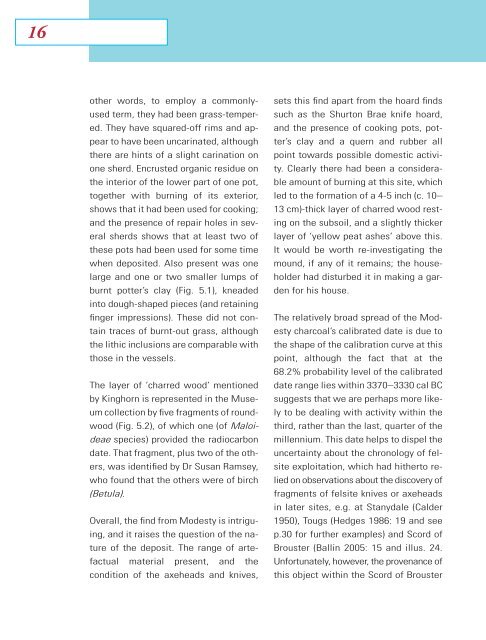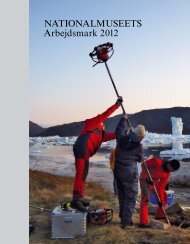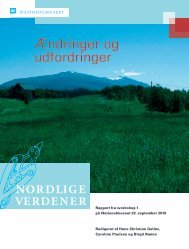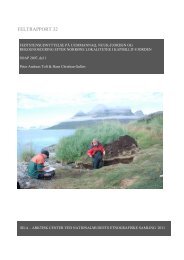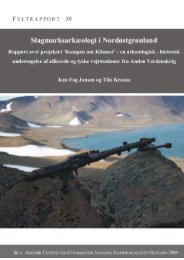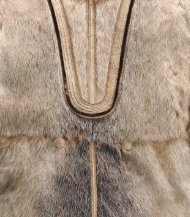The Border of Farming and the Cultural Markers - Nordlige Verdener
The Border of Farming and the Cultural Markers - Nordlige Verdener
The Border of Farming and the Cultural Markers - Nordlige Verdener
Create successful ePaper yourself
Turn your PDF publications into a flip-book with our unique Google optimized e-Paper software.
16<br />
o<strong>the</strong>r words, to employ a commonlyused<br />
term, <strong>the</strong>y had been grass-tempered.<br />
<strong>The</strong>y have squared-<strong>of</strong>f rims <strong>and</strong> appear<br />
to have been uncarinated, although<br />
<strong>the</strong>re are hints <strong>of</strong> a slight carination on<br />
one sherd. Encrusted organic residue on<br />
<strong>the</strong> interior <strong>of</strong> <strong>the</strong> lower part <strong>of</strong> one pot,<br />
toge<strong>the</strong>r with burning <strong>of</strong> its exterior,<br />
shows that it had been used for cooking;<br />
<strong>and</strong> <strong>the</strong> presence <strong>of</strong> repair holes in several<br />
sherds shows that at least two <strong>of</strong><br />
<strong>the</strong>se pots had been used for some time<br />
when deposited. Also present was one<br />
large <strong>and</strong> one or two smaller lumps <strong>of</strong><br />
burnt potter’s clay (Fig. 5.1), kneaded<br />
into dough-shaped pieces (<strong>and</strong> retaining<br />
finger impressions). <strong>The</strong>se did not contain<br />
traces <strong>of</strong> burnt-out grass, although<br />
<strong>the</strong> lithic inclusions are comparable with<br />
those in <strong>the</strong> vessels.<br />
<strong>The</strong> layer <strong>of</strong> ‘charred wood’ mentioned<br />
by Kinghorn is represented in <strong>the</strong> Museum<br />
collection by five fragments <strong>of</strong> roundwood<br />
(Fig. 5.2), <strong>of</strong> which one (<strong>of</strong> Maloideae<br />
species) provided <strong>the</strong> radiocarbon<br />
date. That fragment, plus two <strong>of</strong> <strong>the</strong> o<strong>the</strong>rs,<br />
was identified by Dr Susan Ramsey,<br />
who found that <strong>the</strong> o<strong>the</strong>rs were <strong>of</strong> birch<br />
(Betula).<br />
Overall, <strong>the</strong> find from Modesty is intriguing,<br />
<strong>and</strong> it raises <strong>the</strong> question <strong>of</strong> <strong>the</strong> nature<br />
<strong>of</strong> <strong>the</strong> deposit. <strong>The</strong> range <strong>of</strong> artefactual<br />
material present, <strong>and</strong> <strong>the</strong><br />
condition <strong>of</strong> <strong>the</strong> axeheads <strong>and</strong> knives,<br />
sets this find apart from <strong>the</strong> hoard finds<br />
such as <strong>the</strong> Shurton Brae knife hoard,<br />
<strong>and</strong> <strong>the</strong> presence <strong>of</strong> cooking pots, potter’s<br />
clay <strong>and</strong> a quern <strong>and</strong> rubber all<br />
point towards possible domestic activity.<br />
Clearly <strong>the</strong>re had been a considerable<br />
amount <strong>of</strong> burning at this site, which<br />
led to <strong>the</strong> formation <strong>of</strong> a 4-5 inch (c. 10–<br />
13 cm)-thick layer <strong>of</strong> charred wood resting<br />
on <strong>the</strong> subsoil, <strong>and</strong> a slightly thicker<br />
layer <strong>of</strong> ‘yellow peat ashes’ above this.<br />
It would be worth re-investigating <strong>the</strong><br />
mound, if any <strong>of</strong> it remains; <strong>the</strong> householder<br />
had disturbed it in making a garden<br />
for his house.<br />
<strong>The</strong> relatively broad spread <strong>of</strong> <strong>the</strong> Modesty<br />
charcoal’s calibrated date is due to<br />
<strong>the</strong> shape <strong>of</strong> <strong>the</strong> calibration curve at this<br />
point, although <strong>the</strong> fact that at <strong>the</strong><br />
68.2% probability level <strong>of</strong> <strong>the</strong> calibrated<br />
date range lies within 3370–3330 cal BC<br />
suggests that we are perhaps more likely<br />
to be dealing with activity within <strong>the</strong><br />
third, ra<strong>the</strong>r than <strong>the</strong> last, quarter <strong>of</strong> <strong>the</strong><br />
millennium. This date helps to dispel <strong>the</strong><br />
uncertainty about <strong>the</strong> chronology <strong>of</strong> felsite<br />
exploitation, which had hi<strong>the</strong>rto relied<br />
on observations about <strong>the</strong> discovery <strong>of</strong><br />
fragments <strong>of</strong> felsite knives or axeheads<br />
in later sites, e.g. at Stanydale (Calder<br />
1950), Tougs (Hedges 1986: 19 <strong>and</strong> see<br />
p.30 for fur<strong>the</strong>r examples) <strong>and</strong> Scord <strong>of</strong><br />
Brouster (Ballin 2005: 15 <strong>and</strong> illus. 24.<br />
Unfortunately, however, <strong>the</strong> provenance <strong>of</strong><br />
this object within <strong>the</strong> Scord <strong>of</strong> Brouster


